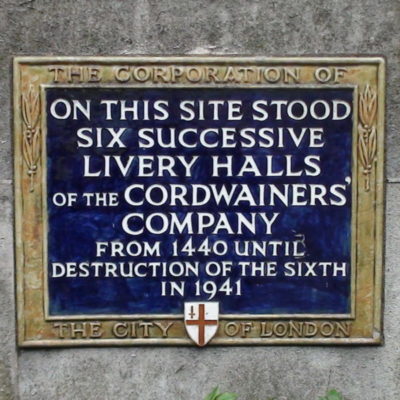On 10 May 1941, London was subjected to one of the most intense nights of bombing of the Blitz.
The City had been relentlessly attacked by the Luftwaffe for six months and on the night of 10-11 May more than 500 bombers attacked London. It was to be the last major raid of the Blitz, and it was undoubtedly the deadliest, killing 1,436 Londoners and injuring a further 2,000 people.
Located just a few hundred yards from St Paul’s Cathedral, Cordwainers’ Hall in Canon Street was one of the casualties. Our hall was comprehensively destroyed by fire, leaving just a bare shell and a solitary goats head above the portico. Only a few images exist of the ruins, but we are fortunate to have a comprehensive account, written by the Company Clerk, Frederick W. Mander.
On 28 May 1941 he issued a five-page report to the Court, which is notable for its concise presentation of the facts and a barely disguised anger at the lack of support from the City authorities.

Cordwainers’ Hall was destroyed not by a direct hit from a bomb, but by blast damage and the fires set by the high explosive incendiaries. As Mander said, ‘the reason for not stopping these two fires was because of the complete lack of water, the Authorities through want of foresight having almost entirely overlooked a reserve supply. . . By unlucky chance for the City one of the earliest bombs destroyed the main water supply, the fire Brigade could obtain no water from the river, the Authorities appear to have provided no reserve and the fires burnt at their will’.
In addition to these problems, there was a full moon and an extremely low ebb tide. The over-stretched London Fire Brigade recorded more than 2,000 fires and with water in short supply, the raid caused more than 7,000 acres of devastation, double that of the Great Fire of London three centuries earlier.
The Clerk’s report overflows with frustration, as he recounts his efforts to return to the damaged building days later to assess the damage more thoroughly and to salvage what he could.
‘It is by no means easy to approach a damaged building. The policy of the Corporation appears to be:- Do not allow the Citizens to approach damaged buildings to salve any portion of their property, they can claim compensation, entirely forgetting the sentimental value attached to some effects and the doubts and difficulties in claiming compensation.’
Fortunately, the bulk of the Company treasures were saved, the most valuable having been stored out of London since 1939. The hall, however, was a great loss and 80 years on, the Cordwainers, like many other livery companies, still lack a hall of their own. Today all that remains to mark the site is a sadly inaccurate plaque in the Festival Gardens by St Paul’s (there were only actually five halls).
